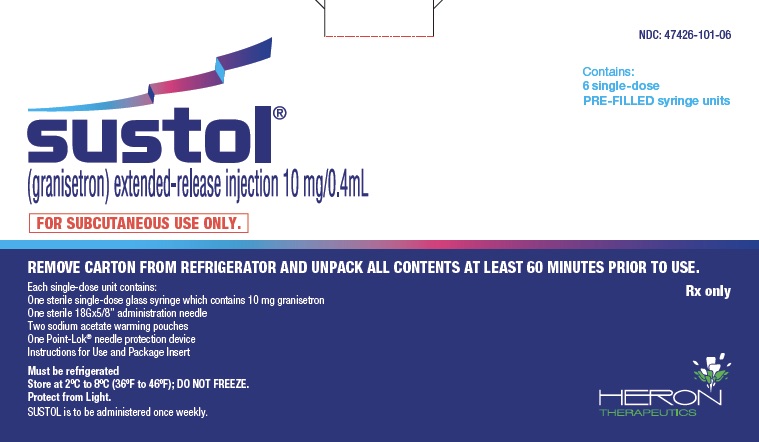Sustol
Generic name: granisetron (injection)
Drug class: 5HT3 receptor antagonists
Medically reviewed by A Ras MD.
What is Sustol used for?
Sustol is a prescription medicine that is used to prevent upset stomach and throwing up.
Description
SUSTOL (granisetron) extended-release injection, contains granisetron, a serotonin-3 (5-HT3) receptor antagonist. Granisetron is 1-methyl-N-[(1R,3r,5S)-9-methyl-9-azabicyclo[3.3.1]non-3-yl]-1H-indazole-3-carboxamide with a molecular weight of 312.4. Its empirical formula is C18H24N4O, with the following chemical structure:
 |
Granisetron is a white to off-white crystalline solid that is insoluble in water.
SUSTOL is a sterile, clear, colorless to slightly yellow, viscous liquid supplied in a single-dose, pre-filled syringe. Each syringe contains 10 mg granisetron incorporated in an extended-release polymer formulation; the inactive ingredients are triethylene glycol poly(orthoester) polymer, 392 mg and polyethylene glycol monomethyl ether, NF, 98 mg.
Mechanism of Action
Granisetron is a selective 5-hydroxytryptamine3 (5-HT3) receptor antagonist with little or no affinity for other serotonin receptors, including 5-HT1, 5-HT1A, 5-HT1B/C, 5-HT2; for alpha1-, alpha2-, or beta-adrenoreceptors; for dopamine-D2; or for histamine-H1; benzodiazepine; picrotoxin or opioid receptors.
Serotonin receptors of the 5-HT3 type are located peripherally on vagal nerve terminals and centrally in the chemoreceptor trigger zone of the area postrema. During chemotherapy that induces vomiting, mucosal enterochromaffin cells release serotonin, which stimulates 5-HT3 receptors. This evokes vagal afferent discharge, inducing vomiting. Animal studies demonstrate that, in binding to 5-HT3 receptors, granisetron blocks serotonin stimulation and subsequent vomiting after emetogenic stimuli such as cisplatin. In the ferret animal model, a single granisetron injection prevented vomiting due to high-dose cisplatin or arrested vomiting within 5 to 30 seconds.
Before taking Sustol, tell your doctor:
- If you are allergic to Sustol; any part of this medicine; or any other drugs, foods, or substances. Tell your doctor about the allergy and what signs you had.
- If you have kidney problems.
This is not a list of all drugs or health problems that interact with this medicine.
Tell your doctor and pharmacist about all of your drugs (prescription or OTC, natural products, vitamins) and health problems. You must check to make sure that it is safe for you to take Sustol with all of your drugs and health problems. Do not start, stop, or change the dose of any drug without checking with your doctor.
What are some things I need to know or do while I take Sustol?
- Tell all of your health care providers that you take Sustol. This includes your doctors, nurses, pharmacists, and dentists.
- Tell your doctor if you are pregnant, plan on getting pregnant, or are breast-feeding. You will need to talk about the benefits and risks to you and the baby.
- It is common to have injection site reactions with Sustol. Some injection site reactions may happen up to 2 weeks or more after getting Sustol. Some of these reactions may be very bad and need treatment. Talk with your doctor.
- Allergic reactions may happen up to 7 days or more after getting Sustol. Talk with your doctor.
How is Sustol best taken?
Use Sustol as ordered by your doctor. Read all information given to you. Follow all instructions closely.
- It is given as a shot into the fatty part of the skin.
What do I do if I miss a dose?
- Call your doctor to find out what to do.
What are the side effects of Sustol that I need to call my doctor about immediately?
WARNING/CAUTION: Even though it may be rare, some people may have very bad and sometimes deadly side effects when taking a drug. Tell your doctor or get medical help right away if you have any of the following signs or symptoms that may be related to a very bad side effect:
- Signs of an allergic reaction, like rash; hives; itching; red, swollen, blistered, or peeling skin with or without fever; wheezing; tightness in the chest or throat; trouble breathing, swallowing, or talking; unusual hoarseness; or swelling of the mouth, face, lips, tongue, or throat.
- Chest pain or pressure.
- Fast or abnormal heartbeat.
- Very bad dizziness or passing out.
- Shortness of breath.
- Fever, chills, or sore throat.
- Stomach pain.
- Swelling of belly.
- A severe and sometimes deadly problem called serotonin syndrome may happen. The risk may be greater if you also take certain other drugs. Call your doctor right away if you have agitation; change in balance; confusion; hallucinations; fever; fast or abnormal heartbeat; flushing; muscle twitching or stiffness; seizures; shivering or shaking; sweating a lot; severe diarrhea, upset stomach, or throwing up; or very bad headache.
- Injection site pain or tenderness that you need to take a pain drug for or that causes problems with daily living.
- Area that feels hard or bruise at the injection site that does not go away.
- Signs of infection at the injection site like redness, warmth of the skin, or fever.
- Bleeding at the injection site that is very bad or lasts longer than 24 hours.
- Constipation that may be very bad can happen with Sustol. This can happen up to 7 days after getting Sustol. Some people have had to go to the hospital to be treated for very bad constipation. Call your doctor right away if you have constipation or if it gets worse after you use Sustol.
What are some other side effects of Sustol?
All drugs may cause side effects. However, many people have no side effects or only have minor side effects. Call your doctor or get medical help if any of these side effects or any other side effects bother you or do not go away:
- Headache.
- Feeling dizzy, tired, or weak.
- Diarrhea or constipation.
- Heartburn.
- Trouble sleeping.
These are not all of the side effects that may occur. If you have questions about side effects, call your doctor. Call your doctor for medical advice about side effects.
You may report side effects to the FDA at 1-800-332-1088. You may also report side effects at https://www.fda.gov/medwatch.
If overdose is suspected:
If you think there has been an overdose, call your poison control center or get medical care right away. Be ready to tell or show what was taken, how much, and when it happened.
How do I store and/or throw out Sustol?
- If you need to store Sustol at home, talk with your doctor, nurse, or pharmacist about how to store it.
Label
Principal Panel – Carton of Six Kits
- SUSTOL®
(granisetron) extended-release injection 10 mg/0.4 mL - FOR SUBCUTANEOUS USE ONLY.
- REMOVE CARTON FROM REFRIGERATOR AND UNPACK ALL CONTENTS AT LEAST 60 MINUTES PRIOR TO USE.
- Each single-dose unit contains:
One sterile single-dose glass syringe which contains 10 mg granisetron
One sterile 18Gx5/8″ administration needle
Two sodium acetate warming pouches
One Point-Lok®,needle protection device
Instructions for Use and Package Insert - Must be refrigerated
Store at 2°C to 8°C (36°F to 46°F); DO NOT FREEZE.
Protect from Light. - SUSTOL is to be administered once weekly.
- NDC: 47426-101-06
- Contains:
6 single-dose
PRE-FILLED syringe units - Rx only
- HERON
THERAPEUTICS
 |
SRC: NLM .